The Butter Steak: What''s the Best Way to Cook a Steak?
How to cook your next porterhouse.
I'm not interested in carbonizing the surface of the meat. To me that ruins the flavor.
- Alain Ducasse
It was a bachelor weekend of sorts. My wife mercifully let me pass on attending a wedding of an old family family friend, so I had the whole weekend alone in the apartment to get work done. I had some crazy projects planned including a mad braise of a cow tongue, but the first night alone was all about pure unrestrained male gluttony. I bought a bottle of wine, a potato the size of a shoe, and an enormous rib eye.
This should have been a simple meal, one requiring little skill beside turning on the stove and plopping a pan on a burner. But somewhere along the way I realized I hadn't eaten much ribeye in my life and I began to wonder whether this stove-top method was the best way to do it. The only "steaks" I tend to eat are skirt or flank, as they're about the only ones I can afford. This splurge had me stumped. Should a sear it on an iron skillet , broil it , or should I dump a bunch of charcoal into my little hibachi and try to get that sucker as hot as possible? Really, what is the best way to cook a ribeye?
My initial thought was to mimic the technique nearly every serious steak house in the Midwest does: broiling it under an inferno. And I mean that. They reguarly reach hellish temperatures of around 1800 degrees. The quick sear blackens the outside while leaving the inside nice and rare. Of course, much like the perfect New York pizza oven, one cannot easily recreate this temperature at home. I could only try hard and hope to get close. I was looking around on eGullet to see if there was a better way of doing this when I came across an article called The Best Way to Cook a Thick Steak . I figured it would be a good place to start.
But I was a little taken aback by what I read. Instead of hellish temperatures, and visible flames, this article claimed that the best way to cook a steak was over medium heat in a skillet bathed in butter . The reasoning is that while high temperatures do a good job of searing the meat, they create burnt flavors. This more moderate approach allows for even cooking and a great flavor because of the Maillard Reaction. And suddenly, and without warning, my simple meal of meat and potatoes required a science lesson.
And it's science that I don't quite understand. I am a little out of my league. Maybe one day I'll indulge in a more serious scan of Harold McGee to better grasp. They even linked to an article by Alain Ducasse , a very muddled essay in the New York Times about how this is the way he likes to cook his steak. He casually mentions that those high heat methods burn the steak, and that he thinks steak tastes better when cooked in a moderate pan with loads and loads butter. Even Tom Colicchio is also a fan of this method, claiming he can "get a crust this way."
Though I am intrigued by the science, what honestly sold me was the serious food porn on eGullet's site. Even though I was a little skeptical about the idea, I just couldn't get these images out of my head.
It would require skill and care. The steak is first cooked on its edge to render some of the beef fat and lubricate the pan, then flipped onto its side and cooked in its own fat for a few minutes. Then the fat is poured out and a lot of butter is added. A LOT of butter.
Still I had my doubts. I worried that the relatively long cooking times would mean my steak would cook past medium rare. I worried that all I was going to taste was butter. And mostly I worried I hadn't been gluttonous enough. Ducasse recommended a steak that was 24 ounces and an inch and half thick. The one I picked up was only 17 ounces and only an inch and a quarter, which was still more than I'd ever need on a normal night.
I adjusted the cooking times, hoping that I could still get a nice a rare steak, but I was just a little off. Mine got just a tad too close to medium, which makes me wonder whether this technique is only good at cooking insanely big steaks that I'll only cook once a year, if that often. But I think the technique is right. Next time I might start with butter sooner in the process, flip more often, and pay just a little more attention to it. Because once you see this crust, man...it's hard to look away.
The Butter Steak
- 1 16-ounce Ribeye
- 2 tablespoons butter
- 2 cloves garlic
- salt and pepper
I set an iron skillet over medium heat. Then I set the ribeye on its fatty edge upright in the skillet.
I cooked it for about 5 minutes until it had rendered a decent amount of fat.
I flipped it on to one flat side and cook it for about 5 minutes. Then flipped it and cooked it for about 3 more.
I removed the steak, poured off the beef fat, and added the butter and garlic.
The steak was returned to the skillet on the side it had cooked on the least, sprinkled with salt, and cooked for about 6 minutes. During that time I basted it continuously with the butter. Then I flipped it, sprinkled that side with salt, and cooked it for about 3 minutes continuing to baste it with butter.
It then rested for about 10 minutes. Ducasse's rule of thumb is that it need half as long as it takes to cook the meat. It was seasoned with more salt and pepper and sliced up.
As you can (sort of) see, I cooked mine just a tad too much. The middle is way past red and into a muted pink territory. It's a little hard to see, but there is a definite band of pink. But the crust is off the charts.
Food, Main Course, Agriculture, Alain Ducasse, Alain Ducasse, American, American cuisine, Beef, Beef, Butter, Butter, Cooking, Cuts of beef, eGullet, Food and drink, Harold McGee, Meat, New York, Rib Eye, Rib eye steak, Steak, Steak, Steak au poivre, The New York Times, The New York Times

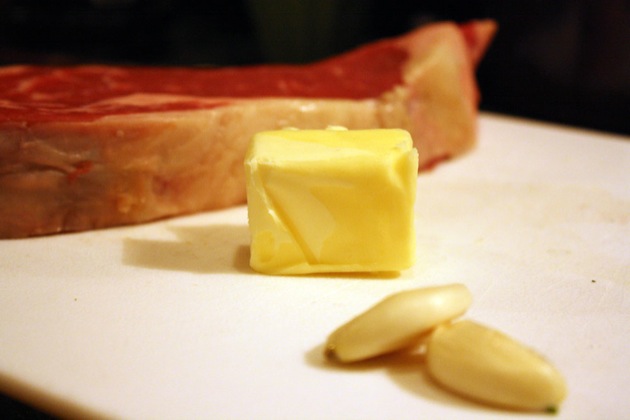
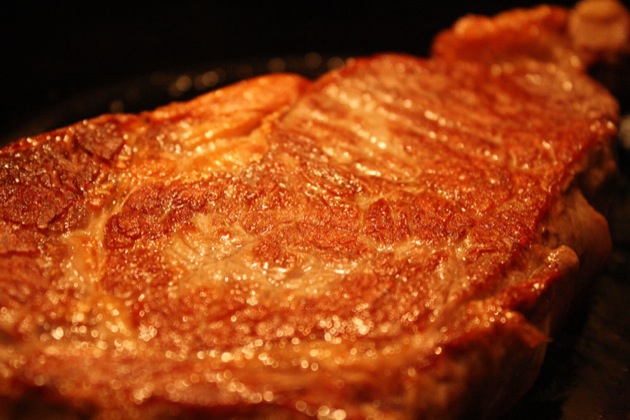
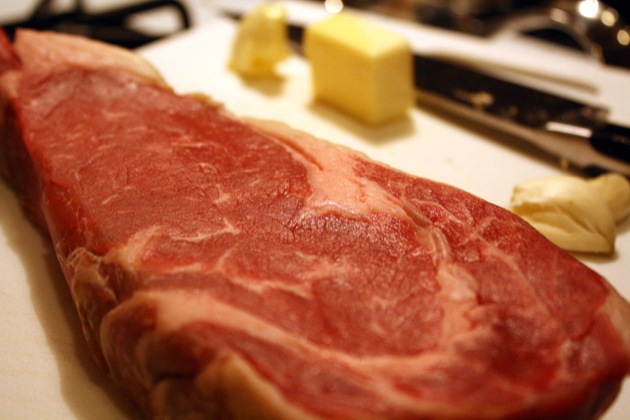
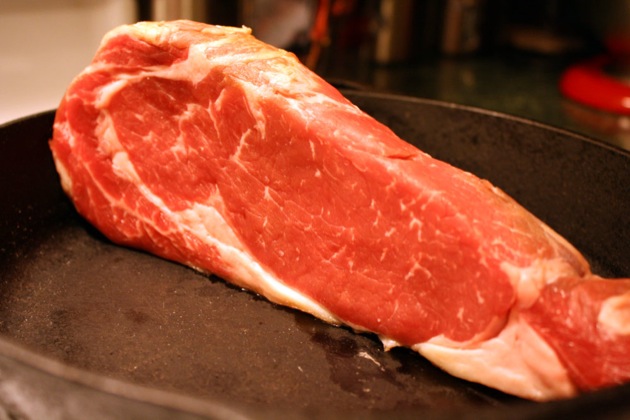
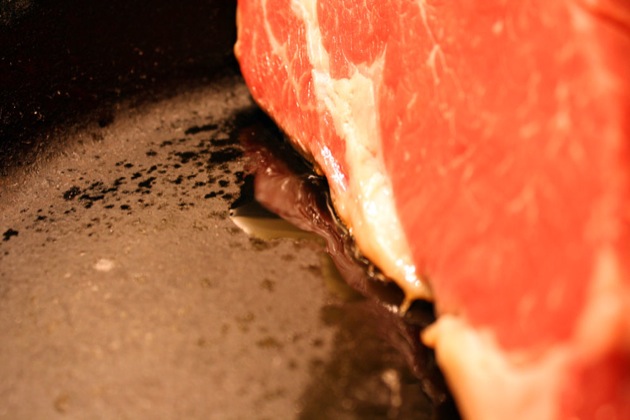
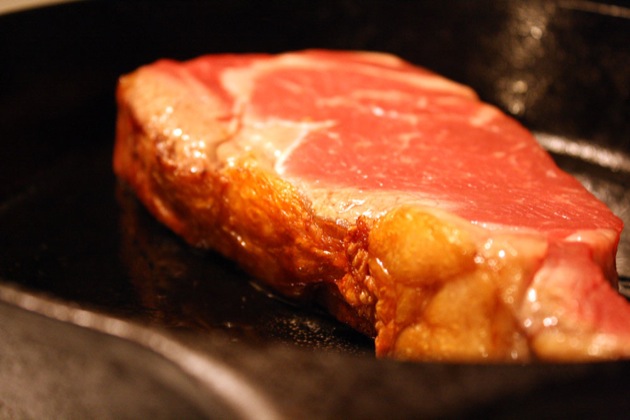
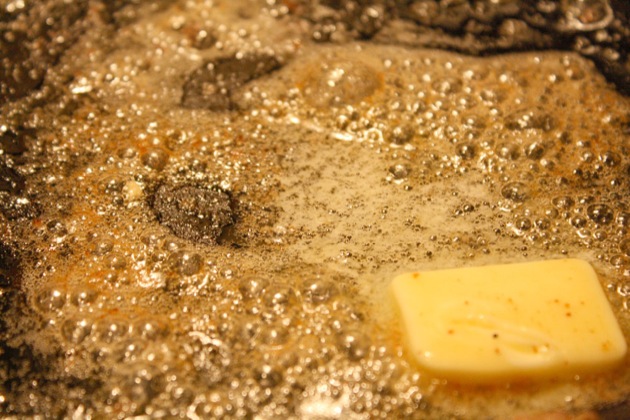
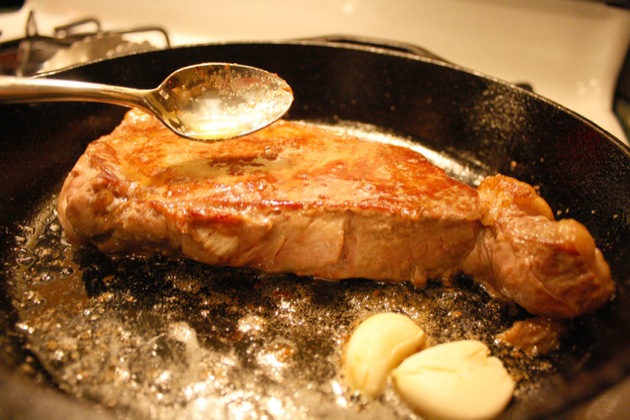
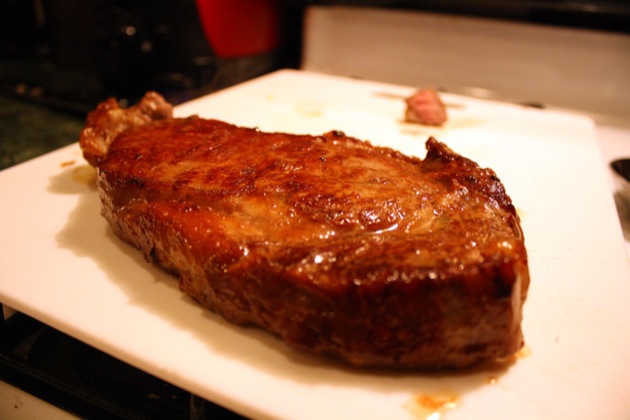
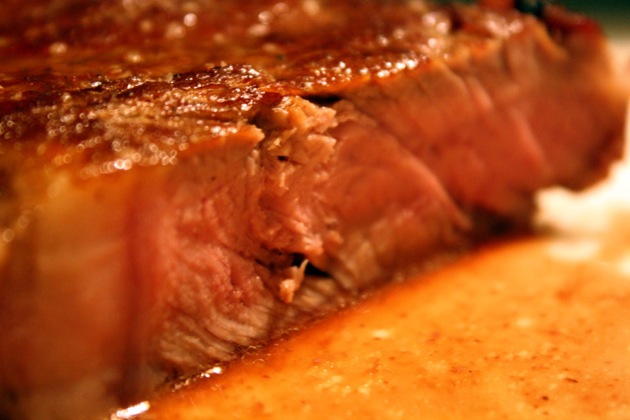
Comments:
Blog Comments powered by Disqus.